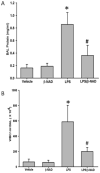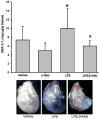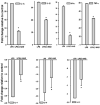β-Nicotinamide adenine dinucleotide attenuates lipopolysaccharide-induced inflammatory effects in a murine model of acute lung injury
- PMID: 22563684
- PMCID: PMC3678723
- DOI: 10.3109/01902148.2012.673049
β-Nicotinamide adenine dinucleotide attenuates lipopolysaccharide-induced inflammatory effects in a murine model of acute lung injury
Abstract
Acute lung injury (ALI) and acute respiratory distress syndrome (ARDS) occur in approximately 200,000 patients per year. Studies indicate that lung endothelium plays a significant role in ALI. The authors' recent in vitro studies demonstrate a novel mechanism of β-nicotinamide adenine dinucleotide (β-NAD)-induced protection against gram-positive (pneumolysin, PLY) and gram-negative (lipopolysaccharide, LPS) toxin-induced lung endothelial cell (EC) barrier dysfunction. The objective of the current study was to evaluate the protective effect of β-NAD against LPS-induced ALI in mice. C57BL/6J mice were randomly divided into 4 groups: vehicle, β-NAD, LPS, and LPS/β-NAD. After surgery, mice were allowed to recover for 24 hours. Evans blue dye-albumin (EBA) was given through the internal jugular vein 2 hours prior to the termination of the experiments. Upon sacrificing the animals, bronchoalveolar lavage fluid (BALF) was collected and the lungs were harvested. β-NAD treatment significantly attenuated the inflammatory response by means of reducing the accumulation of cells and protein in BALF, blunting the parenchymal neutrophil infiltration, and preventing capillary leak. In addition, the histological examination demonstrated decreased interstitial edema in the LPS/β-NAD specimens, as compared to the LPS-only specimens. The mRNA levels of the anti-inflammatory cytokines were up-regulated in the LPS group treated with β-NAD compared to the LPS-only-treated group. β-NAD treatment down-regulated the mRNA levels of the proinflammatory cytokines. These findings suggest that β-NAD could be investigated as a therapeutic option against bacterial toxin-induced lung inflammation and ALI in mice.
Conflict of interest statement
Figures





Similar articles
-
Protective effect of adenosine receptors against lipopolysaccharide-induced acute lung injury.Am J Physiol Lung Cell Mol Physiol. 2014 Mar 15;306(6):L497-507. doi: 10.1152/ajplung.00086.2013. Epub 2014 Jan 10. Am J Physiol Lung Cell Mol Physiol. 2014. PMID: 24414256 Free PMC article.
-
Inhibition of Pendrin by a small molecule reduces Lipopolysaccharide-induced acute Lung Injury.Theranostics. 2020 Aug 7;10(22):9913-9922. doi: 10.7150/thno.46417. eCollection 2020. Theranostics. 2020. PMID: 32929324 Free PMC article.
-
Rhesus θ-Defensin-1 Attenuates Endotoxin-induced Acute Lung Injury by Inhibiting Proinflammatory Cytokines and Neutrophil Recruitment.Am J Respir Cell Mol Biol. 2018 Mar;58(3):310-319. doi: 10.1165/rcmb.2016-0428OC. Am J Respir Cell Mol Biol. 2018. PMID: 28954201 Free PMC article.
-
Inhibitory effects of flavonoids extracted from licorice on lipopolysaccharide-induced acute pulmonary inflammation in mice.Int Immunopharmacol. 2009 Feb;9(2):194-200. doi: 10.1016/j.intimp.2008.11.004. Epub 2008 Dec 9. Int Immunopharmacol. 2009. PMID: 19071231
-
Knockdown of TFPI-Anchored Endothelial Cells Exacerbates Lipopolysaccharide-Induced Acute Lung Injury Via NF-κB Signaling Pathway.Shock. 2019 Feb;51(2):235-246. doi: 10.1097/SHK.0000000000001120. Shock. 2019. PMID: 29438223 Free PMC article.
Cited by
-
Method for the Culture of Mouse Pulmonary Microvascular Endothelial Cells.Sci Pages Pulmonol. 2017;1(1):7-18. Sci Pages Pulmonol. 2017. PMID: 29658013 Free PMC article.
-
β-Nicotinamide Adenine Dinucleotide (β-NAD) Inhibits ATP-Dependent IL-1β Release from Human Monocytic Cells.Int J Mol Sci. 2018 Apr 10;19(4):1126. doi: 10.3390/ijms19041126. Int J Mol Sci. 2018. PMID: 29642561 Free PMC article.
-
Protective effect of Growth Hormone-Releasing Hormone agonist in bacterial toxin-induced pulmonary barrier dysfunction.Front Physiol. 2014 Jul 15;5:259. doi: 10.3389/fphys.2014.00259. eCollection 2014. Front Physiol. 2014. PMID: 25076911 Free PMC article.
-
Protective effect of adenosine receptors against lipopolysaccharide-induced acute lung injury.Am J Physiol Lung Cell Mol Physiol. 2014 Mar 15;306(6):L497-507. doi: 10.1152/ajplung.00086.2013. Epub 2014 Jan 10. Am J Physiol Lung Cell Mol Physiol. 2014. PMID: 24414256 Free PMC article.
-
Site-specific and endothelial-mediated dysfunction of the alveolar-capillary barrier in response to lipopolysaccharides.J Cell Mol Med. 2018 Feb;22(2):982-998. doi: 10.1111/jcmm.13421. Epub 2017 Dec 5. J Cell Mol Med. 2018. PMID: 29210175 Free PMC article.
References
-
- Abraham E. Neutrophils and acute lung injury. Crit Care Med. 2003;31(4 Suppl):S195–S199. - PubMed
-
- Razavi HM, Wang le F, Weicker S, Rohan M, Law C, McCormack DG, et al. Pulmonary neutrophil infiltration in murine sepsis: role of inducible nitric oxide synthase. Am J Respir Crit Care Med. 2004;170:227–233. - PubMed
-
- Wang le F, Patel M, Razavi HM, Weicker S, Joseph MG, McCormack DG, et al. Role of inducible nitric oxide synthase in pulmonary microvascular protein leak in murine sepsis. Am J Respir Crit Care Med. 2002;165:1634–1639. - PubMed
-
- Suda K, Tsuruta M, Eom J, Or C, Mui T, Jaw JE, et al. Acute lung injury induced cardiovascular dysfunction: effects of IL-6 and budesonide/formoterol. Am J Respir Cell Mol Biol. 2011 Jan 21;45:510–516. - PubMed
-
- Ware LB, Matthay MA. The acute respiratory distress syndrome. N Engl J Med. 2000;342:1334–1349. - PubMed
Publication types
MeSH terms
Substances
Grants and funding
LinkOut - more resources
Full Text Sources
Medical
Molecular Biology Databases
